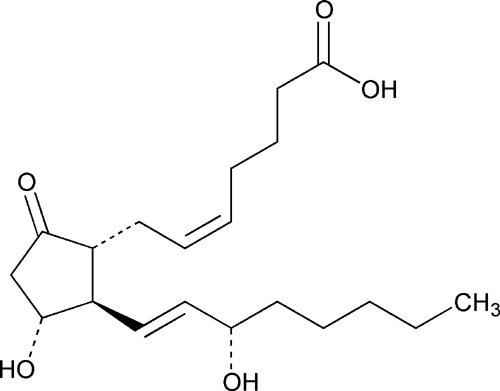Dinoprostone
» Dinoprostone contains not less than 97.0 percent and not more than 103.0 percent of C20H32O5.
Packaging and storage—
Preserve in well-closed, light-resistant containers.
USP Reference standards  11
11 —
—
USP Dinoprostone RS.
USP Dinoprostone RS.
Identification—
A:
Infrared Absorption  197K
197K .
.
B:
The retention time of the major peak in the chromatogram of the Assay preparation corresponds to that in the chromatogram of the Standard preparation, as obtained in the Assay.
Specific rotation  781S
781S :
between –82.0
:
between –82.0 and –90.0
and –90.0 , at 20
, at 20 .
.
Test solution:
5 mg per mL, in alcohol.
Water, Method I  921
921 :
not more than 0.5%.
:
not more than 0.5%.
Residue on ignition  281
281 :
not more than 0.5%.
:
not more than 0.5%.
Chromatographic purity—
Mobile phase—
Proceed as directed in the Assay.
Standard stock solution—
Prepare as directed for Standard preparation in the Assay.
Standard solution—
Transfer 0.5 mL of the Standard stock solution to a 50-mL volumetric flask, dilute with Mobile phase to volume, and mix.
Test solution—
Prepare as directed for Assay preparation.
Chromatographic system (see Chromatography  621
621 )—
Prepare as directed in the Assay. Chromatograph the Standard stock solution, and record the peak responses as directed for Procedure: the column efficiency is not less than 6000 theoretical plates; and the relative standard deviation for replicate injections is not more than 2.0%. Chromatograph the Test solution, and record the peak responses as directed for Procedure: the resolution, R, between dinoprostone and any other adjacent peak is not less than 1.0.
)—
Prepare as directed in the Assay. Chromatograph the Standard stock solution, and record the peak responses as directed for Procedure: the column efficiency is not less than 6000 theoretical plates; and the relative standard deviation for replicate injections is not more than 2.0%. Chromatograph the Test solution, and record the peak responses as directed for Procedure: the resolution, R, between dinoprostone and any other adjacent peak is not less than 1.0.
Procedure—
Separately inject equal volumes (about 20 µL) of the Standard solution and the Test solution into the chromatograph, record the chromatograms, and measure the peak responses. Calculate the percentage of each impurity in the portion of Dinoprostone taken by the formula:
(C / W)(1 / F)(ri / rS)
in which C is the concentration, in µg per mL, of USP Dinoprostone RS in the Standard solution; W is the weight, in mg, of Dinoprostone taken to prepare the Test solution; F is the relative response factor (see Table 1 for values); ri is the peak response for each impurity obtained from the Test solution; and rS is the peak response for dinoprostone obtained from the Standard solution.
Table 1
| Impurity | Relative Retention Time |
F | Limit |
| 15-oxo-dinoprostone | 0.79 | 5 | * |
| 15-epi-dinoprostone | 0.85 | 1.1 | * |
| 8-isodinoprostone | 0.90 | 1.0 | * |
| 5,6-trans-dinoprostone | 1.15 | 1.0 | Not more than 2.0% |
| (5Z,13E,15S)-15-hydroxy-9-oxoprosta-5, 10,13-triene-1-oic acid | 1.80 | 5 | Not more than 1.0% |
| (5Z,13E,15S)-15-hydroxy-9-oxoprosta-5, 8(12),13-trien-1-oic acid | 1.90 | 1.43 | Not more than 1.0% |
| Any other impurity | — | 1.0 | Not more than 0.1% of total other impurities present |
|
*
The sum of these three impurities is not more than 1.0%.
|
|||
Assay—
Mobile phase—
Prepare a filtered and degassed mixture of methanol and 0.2% acetic acid (58:42). Make adjustments if necessary (see System Suitability under Chromatography  621
621 ).
).
Standard preparation—
Dissolve an accurately weighed quantity of USP Dinoprostone RS in Mobile phase, and dilute quantitatively, and stepwise if necessary, with Mobile phase to obtain a solution having a known concentration of about 2.5 mg per mL.
Assay preparation—
Transfer about 25.0 mg of Dinoprostone, accurately weighed, to a 10-mL volumetric flask, dissolve in and dilute with Mobile phase to volume, and mix.
Chromatographic system (see Chromatography  621
621 )—
The liquid chromatograph is equipped with a 210-nm detector and a 4.6-mm × 25-cm column that contains packing L1. The flow rate is about 1 mL per minute. The column temperature is maintained at 30
)—
The liquid chromatograph is equipped with a 210-nm detector and a 4.6-mm × 25-cm column that contains packing L1. The flow rate is about 1 mL per minute. The column temperature is maintained at 30 . Chromatograph the Standard preparation, and record the peak responses as directed for Procedure: the resolution, R, between dinoprostone and any other adjacent peak is not less than 1.0; and the relative standard deviation for replicate injections is not more than 2.0%.
. Chromatograph the Standard preparation, and record the peak responses as directed for Procedure: the resolution, R, between dinoprostone and any other adjacent peak is not less than 1.0; and the relative standard deviation for replicate injections is not more than 2.0%.
Procedure—
Separately inject equal volumes (about 20 µL) of the Standard preparation and the Assay preparation into the chromatograph, record the chromatograms, and measure the responses for the major peaks. Calculate the quantity, in mg, of C20H32O5 in the portion of Dinoprostone taken by the formula:
10C(rU / rS)
in which C is the concentration, in mg per mL, of USP Dinoprostone RS in the Standard preparation; and rU and rS are the peak responses obtained from the Assay preparation and the Standard preparation, respectively.
Auxiliary Information—
Please check for your question in the FAQs before contacting USP.
| Topic/Question | Contact | Expert Committee |
| Monograph | Daniel K. Bempong, Ph.D.
Senior Scientist 1-301-816-8143 |
(MDPS05) Monograph Development-Pulmonary and Steroids |
| Reference Standards | Lili Wang, Technical Services Scientist 1-301-816-8129 RSTech@usp.org |
USP32–NF27 Page 2172
Pharmacopeial Forum: Volume No. 28(1) Page 56
